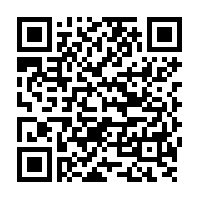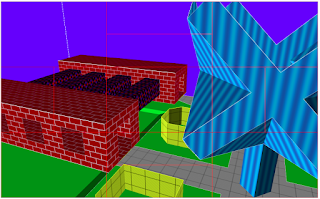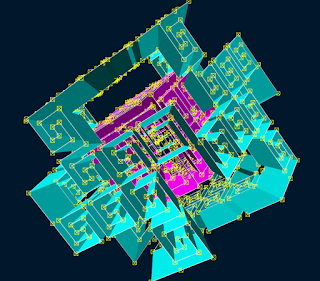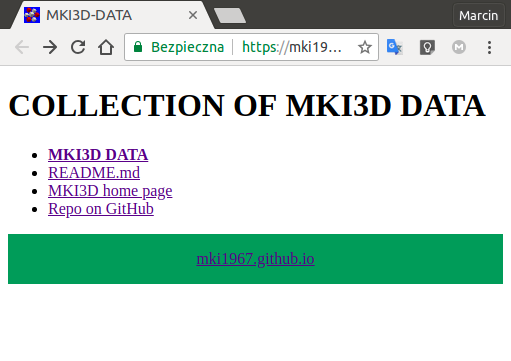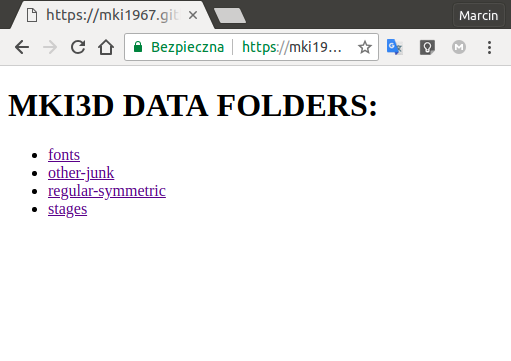In the recent version of
MKI3D you can place URL links in your designed stages that can be followed when the stage is browsed in
MKI3D TRAVEL.
URL submenu
There is a new position
'U' on the main menu:
This is for creating and manipulating URL links. At present, the URL submenu looks like that:
You can add a new empty link at the cursor position by pressing the 'A' key on this submenu.
(There is a minimal distance required between any two links positions.)
The edit ('E'), cut ('X') and paste ('V') actions are performed on the link at cursor position.
There is a new option 'U' at the cursor submenu, the moves the cursor to the position of the nearest link.
Edit URL submenu
The editing of link is done in the following submenu:
The textfields on Edit URL submenu
There are three input text fields for: LABEL, OPENER, and URL.
LABEL may be any any text. It is prominently displayed in the MKI3D TRAVEL, when the user is offered to follow the link.
OPENER and
URL are used to construct the actual URL of the page that is opened by the link.
If
OPENER and
URL are full (i.e. not relative) URLs, then they are simply concatenated.
The result should be a legal full URL that can be opened by the browser.
For example if:
- OPENER is 'https://mki1967.github.io/mki3d/mki3d_www/mki3d.html?input=', and
- URL is 'https://mki1967.github.io/mki3d-data/data/web/stage1.mki3d',
then the actual URL to be opened is:
https://mki1967.github.io/mki3d/mki3d_www/mki3d.html?input=https://mki1967.github.io/mki3d-data/data/web/stage1.mki3d
If
OPENER or
URL is a relative URL, then it is first extended to a full URL
("actual opener URL" or "actual input URL", respectively).
Then the concatenation of "actual opener URL" with "actual input URL" is the URL to be opened by the browser.
The construction is made with the
URL() constructor ,
where a different "base URLs" are used for
OPENER and
URL
( "opener URL base" and "input URL base", respectively).
Computing "actual input URL" from URL
The "actual input URL" is made from the
URL with the "input URL base",
if the
URL is a relative URL.
If the the
MKI3D editor or in the
MKI3D TRAVEL were opened with the parameter '?input=' ,
then the "input URL base" is the URL of the loaded stage.
(The value of the parameter
'?input=' may also be an relative URL. In such case, the "input URL base" is the URL of the document.referrer - the URL of the page from which it is opened.)
Thus the relative URL links in the stage are assumed to have the same base as the stage itself. (This enables desingnig and testing of local webs with the
http://localhost server and then publishing them e.g. by pushing on public static pages such as GitHub Pages.)
Computing "actual opener URL" from OPENER
If the
OPENER is empty the the "actual opener URL" is also empty.
In MKI3D TRAVEL and in
MKI3D editor the "opener URL base" is taken from
window.location.href, thus the OPENER from the link is assumed to have the same base as the current opener of the stage.
Note that
have the same url base.
Thus, if you are working in the editor open from the URL:
https://mki1967.github.io/mki3d/mki3d_www/mki3d.html
and if the link has:
- OPENER : 'travel.html?input=', and
- URL : 'https://mki1967.github.io/mki3d-data/data/web/stage1.mki3d',
then the actual URL to be opened is:
https://mki1967.github.io/mki3d/mki3d_www/travel.html?input=https://mki1967.github.io/mki3d-data/data/web/stage1.mki3d
On the other hand, if the editor were open from URL:
http://localhost:8000/mki3d/mki3d_www/mki3d.html
then the actual URL to be opened by such link would be:
http://localhost:8000/mki3d/mki3d_www/travel.html?input=https://mki1967.github.io/mki3d-data/data/web/stage1.mki3d
This is useful if you want to work with applications served by the http://localhost server
from your local clones of
MKI3D repo.
(You may follow the hints from
README.md of the
mki3d-data repo.)
Probably, you would like to have the links with the short relative URLs, like:
- OPENER: 'travel.html?input=', and
- URL: 'stage1.mki3d'
Remainig options of URL Edit submenu
The 'Tab' key on the submenu lets you test what would be opened with the current values
of OPENER and URL.
Note that the the actual URL opened by the link with relative URLs depends on how the editor was started.
The 'X' and 'V' keys let you cut the link and then paste it in the cursor positions. This is useful if you want to remove the link, or to make many copies or similar links.
The observer is aligned with X,Y,Z axes looking into positive Z direction.
To see the orientation in
MKI3D editor , you should see the cursor like that:
Don't forget to set the proper light direction ('QDL') . It is used in the MKI3D TRAVEL.
I have just created a HTML page on GitHb Pages that is intended to contain a list of links that are entries to the web of MKI3D stages. The address of the page is:
https://mki3d.github.io/mki3d-web-index/
If you want to submit such link to your stage the please read and follow the simple instructions in
README.md. (I short: you just have to open new
issue containing the URL that opens your stage in
MKI3D TRAVEL.)




